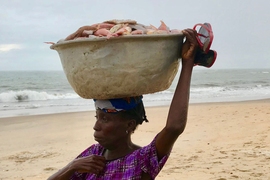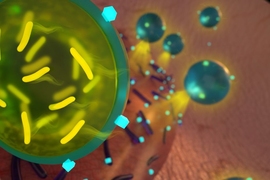Eric Alm is a professor of civil and environmental engineering and biological engineering at MIT and co-director of the Center for Microbiome Informatics and Therapeutics. He also serves on the board of directors for the non-profit stool bank, OpenBiome, and clinical-stage biopharmaceutical company Finch Therapeutics. His work focuses on understanding and engineering the human microbiome, which he defines as the microbes — bacteria, fungi, protozoa, and viruses — that live on and inside the human body. The microbiome plays a key role in human health and disease, and Alm and his colleagues strive to translate basic science discoveries rapidly into clinical settings, where they can contribute to better outcomes for patients.
Q. People are increasingly curious about the state of their microbiome. Could you tell us what a healthy microbiome looks like? Does the number of different types of bacteria species in the microbiome matter for health?
A. We don’t really know if diversity matters. If you’re very unhealthy, diversity in the microbiome can be very low as a result of an infection — where one particular bacterium takes over the gut and diversity goes down because you’ve been colonized by an infectious agent. But more might not necessarily be better if you’re within the range of diversity that is common among healthy people. So a diet or treatment of the microbiome may lead to increased diversity, but that does not mean it’s better or healthier for you. Diversity is not synonymous with healthy, but we don't have anything else that is synonymous with healthy either. Eating plenty of fiber and maintaining a varied diet is probably the best we can do for now until we have better science and knowledge about what healthy means.
Q. You cofounded the Global Microbiome Conservancy (GMbC) to identify and preserve gut bacteria from different peoples around the world. Could you tell us more about what you’re doing and why?
A. The microbiome is very homogenous in populations from industrialized nations that have access to antibiotics, processed foods, and modern sanitation. We have an extensive collection of over 7,000 different microbes that you’d find in folks from North America. But when we looked at the microbial species in people living in less developed nations, we discovered we hadn’t even scratched the surface in terms of microbial diversity, especially among people living "traditional," non-industrialized lifestyles. Those populations have a much greater microbial diversity than we see in North Americans, as well as very different organisms that might have totally different effects on host metabolism. This could be really important for health — not only in developing countries but maybe also for ourselves.
GMbC’s biobank now houses about 4,000 strains from non-industrialized communities in seven countries, and we’re actively sampling in many other locations. We’ve built a global network of about 70 scientists, anthropologists, and collaborators working with indigenous and other non-industrialized communities in about 35 countries. We get samples and bring them back to MIT where we isolate the bacteria and preserve it for future generations so this biodiversity is not lost. Right now the 7,000 strains that we derived from urban North American individuals includes only five previously unknown genera — but the 4,000 strains from the non-industrialized parts of Africa and the Arctic where we’ve sampled have already yielded 55 unknown genera.
Q. You’ve also helped people gain access to a procedure that involves transplanting stool from a healthy donor into the colon of a patient. Could you tell us more about the use of fecal transplants?
A. Clostridium difficile finection is the most common hospital acquired gut infection, and our interest in the disease came after reading a scientific paper that showed fecal transplants work were effective even in cases where standard antibiotic therapy had failed. Patients, however, could not get access to treatment at that time, because doctors didn’t have access to the material for fecal transplants. We knew how to do it in the lab, and in 2013, my graduate student Mark Smith started a non-profit stool bank called OpenBiome, and we treated our first patient later that year. We’ve treated about 40,000 people so far. We’re partnering with over 1,000 hospital networks across the U.S. to make sure everyone has safe access to this medical procedure.
The FDA does not currently allow large-scale treatment for indications other than C. diff. but clinical studies into other applications in various diseases exist. At the Center for Microbiome Informatics and Therapeutics at MIT, for instance, we’re involved in clinical studies that involve fecal transplants for patients with inflammatory bowel disease, or IBD. We look at various strains of bacteria and the immune response and even the metabolites in the blood to see how that changes in response to a fecal transplant. We’re also studying the effects of diet on the microbiome. For example, we know that microbes can metabolize fiber to short chain fatty acids like butyrate, which seems important in IBD. One of the interesting things we’ve found is that depending on the microbiome, different people require different fibers to make butyrate. Some individuals will take inulin and convert it into butyrate but not pectin and vice versa. We are working toward things like personalized fiber supplements for people with IBD.











